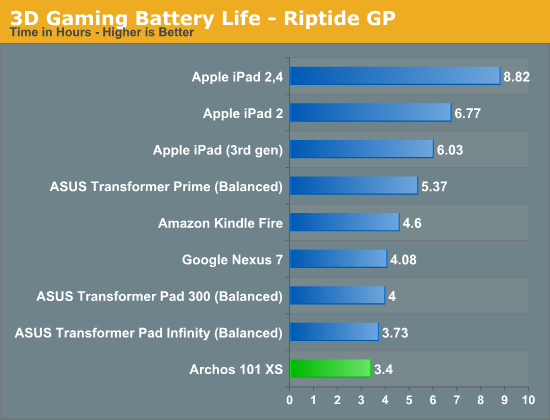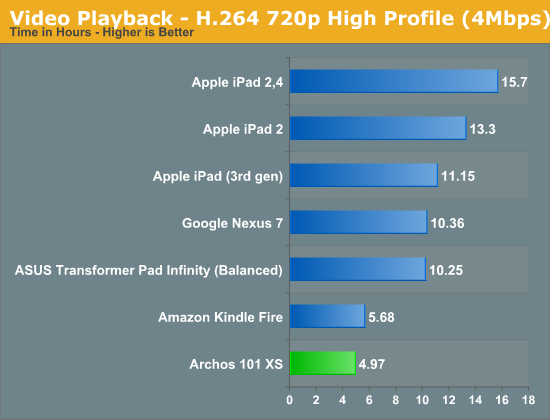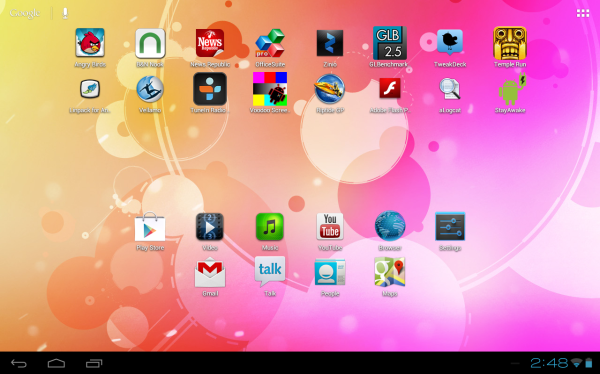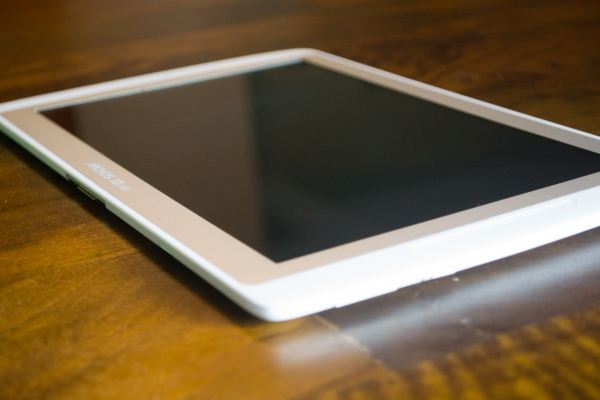The Archos 101 XS Review: Prettier, Faster, So Much Better
by Jason Inofuentes on August 22, 2012 12:15 PM ESTSoftware
Archos has taken an approach to software development that has favored performance by leveraging every hardware advantage possible, and ignoring the urge to muddy the UI with their own skins and widgets. This we knew from their G9s and that persists in the XS. During our interviews with the Archos team leading up to our G9 reviews we also learned that they were committed to maintaining software parity with the G9s even well after successor devices had been released. The release of Jelly Bean has put that promise in a bit of jeopardy but, what we do know is that Archos will still aim for software feature parity across the two lines. That’s not to say they aren’t going to try to get Jelly Bean onto the G9s, simply that their first priority must be to get Jelly Bean optimized for the XS, and then they’ll set their resources onto the G9 build.
I’m hopeful, though. The decision to remain on OMAP 4 has the benefit of being able to use unified source code from which the G9 and XS firmwares are derived. So, once the XS Jelly Bean build is completed, the delta from that to a G9 optimized version of Jelly Bean is much smaller than if the two devices were running entirely different architectures. But even if Jelly Bean doesn’t make an appearance on the G9, Archos remains committed to bringing any optimizations from their Jelly Bean source that could benefit the G9 over to their ICS builds.
As to when that Jelly Bean build for the XS is going to happen . . . Well, it’s not clear, but Archos is hopeful that it could be sometime this fall, which is pretty aggressive considering how late in the summer the XS is being released. As soon as we have an update from Archos on that we’ll pass it on.

As far as this ICS build, well, it is actually a pre-release build and in some ways that shows. Archos has been dinged in the past for some issues with touch performance, and that seems to persist. There’s a significant component of that issue which is due to the hardware, but with the hardware finalized the only way to see any improvement in it is through software updates. Otherwise the UI and software is just like the current firmware for the G9s, with a stock UI and a custom media suite. The massive codec support that impressed us in the G9 remains intact, though that support does not extend to the stock player, only Archos 's own player. This does lead to some curious issues where a particular file won’t play on the Archos player, but plays just fine under the stock player. We’re not sure why the disparity, but so far we haven’t run into a common codec combination that wouldn’t play in either player, so most of your ripped content should playback just fine.
Battery Life
The bulk of the volume and weight of a given tablet is usually the battery. This is certainly true for the Archos 101 XS, whose slim frame is filled with a 25 Whr battery, matching the Transformer Prime, and nearly 10 Whr bigger than the Nexus 7. Like performance, though, battery life owes as much to the software, as it does to the hardware.
Our first test is typically the web browsing test, which cycles through 20 common webpages and tries to foil any caching strategies too ensure that the appropriate radios are activating. Unfortunately, with this pre-release software we encountered some browser instability during testing. We didn’t have any issues with the browser during day to day use, and we’ll update the review once we have a software build that resolves this issue. So, we’ll move on.

The 3D Gaming test is a new one, but one that should give an accurate estimation of the amount of time you can expect to spend playing an graphics intensive game on a given tablet. And things don’t look great for the 101 XS. The OMAP 4470 remains a 45 nm part, so there’s no rewards netted over the prior generation Archos tablets from a process switch. The SGX544 not only retains the higher clock speeds of the SGX540 in the OMAP 4460 (384 Mhz) but it also adds components, so the resulting increase in performance comes at the cost of playtime. It’s not necessarily a bad trade off, as performance is significantly better.

Our video rundown test has been updated, and involves the simple act of looping a movie with the brightness set to 200 nits. In talking to Archos, their testing put this test in the vicinity of 6+ hours; the difference being that they test at 150 nits of brightness to our 200 nits. The bright side of their result is that there are power savings to be gained in lowering the brightness if you can stand it. Otherwise, keep a charger handy.
It's notable that several of the tablets in these charts have 10.1" displays backed by ~25 Whr batteries, so this isn't an issue of battery size. Archos has squeezed a lot of battery into a thin frame. The component power cost is just too high. The display may be inefficient, or the SoC not so quick to spool down, but the video test may point to a bigger issue. Like most modern SoCs TI's OMAP 4 architecture includes explicit video decode IP so that no AP or GPU cycles are used for video playback. The AP and GPU may remain active to handle background tasks or draw UI components for the video player, but even some of that should be handled by the low-power Cortex-M3 cores and the Composition GPU. It's likely that the aggressive governor set by Archos to ensure performance goals is keeping things spooled up a little more than necessary. ASUS' approach has been to offer user controllable governors, and it's an approach that could pay off for Archos, as well.












44 Comments
View All Comments
rwei - Wednesday, August 22, 2012 - link
...wait, what? But iOS didn't exist yet, how could there be rumors of it being used on a tablet? Or do you just mean an Apple tablet in general?JasonInofuentes - Thursday, August 23, 2012 - link
Fair enough, though, most likely, iOS did exist; we just didn't know about it yet.wsjudd - Wednesday, August 22, 2012 - link
Pedantic mode on:The weights in the first table have varying units and spacing (or, for the first one, no units at all).
Weight 600 635g 580.6g 340 g
JasonInofuentes - Thursday, August 23, 2012 - link
Fixed. Thanks.Cheers.
Jason
vthl - Wednesday, August 22, 2012 - link
it feels a little biased and intentional sometimes ..... certain devices always left out of the charts for no reason...... earlier it was macbook pro retina from the samsung Samsung Series 7 notebook in display comparison now nexus 7 etc has been from few comparison lists (but not all).... if you people haven't tested those products in any of the benchmark you are comparing with .... care to put a note in the chart itself (not tested) .JasonInofuentes - Thursday, August 23, 2012 - link
So, a lot of this has to do with the fact that, though we have standard ways of running tests, we don't necessarily have a standard series of tests we perform on all devices. Some of that has to do with time or other resources, some of that has to do with value. Some tests are only pertinent if the value deviates in anyway from expectations. Take, for instance, Anand's recent analysis of IO performance in tablets. Previously, we wouldn't have though to check. As it became an issue, with SoC performance and software putting a higher load on IO, Anand took to analyzing the issue. Given the value focus of the Archos lines, I expect that IO performance won't be groundbreaking. And that might matter. So, I'll look into it, but that involves coordinating with Anand to ensure my testing methodology matches his.And yes, we don't test every device. I'm going to reveal a secret to you all. We're not a large team, all sitting together in a technology playroom, testing devices from sun up till . . . well, sun up. For only a few of us is this our full-time job, and for the rest, we do our best to ensure that the most interesting things make it to the site. And sometimes, we never get chance to find out.
Feel free to let us know when you want to take a closer look at a particular comparison and we'll try and put it together for you. Thanks for reading.
Jason
Wwhat - Wednesday, August 22, 2012 - link
Is it me or does this several page article omit to name its sensors? A small spec list with such things might be appropriate with reviews (even if they are advertisement ones)And while I'm posting: I also was surprised to see how light the nexus is compared to the other tablets, that makes a huge difference I think.
JasonInofuentes - Thursday, August 23, 2012 - link
Lightness is a big plus for one-handed operation of a tablet, and I think it's a component in the growing popularity of smaller tablets. A 1.3 lbs device is fine sitting on my couch, but if I'm standing in a subway car, or playing a game, my arm's can get a little weary. I'd much prefer a lighter device then.As to your other comments, we take all our reader comments into account (even if they are unnecessarily snarky), so I'll try to do better. In this case, the only thing omitted from the usual set of radios is the light sensor.
xaueious - Wednesday, August 22, 2012 - link
I wouldn't be so quick to give Archos any credit for optimizing the browser performance. TI OMAP4 always had an edge in the Sunspider benchmarks, and the performance here is inline with those results. It was TI that did any of the work, not Archos. To be precise, the TI OMAP4 reference was optimized targeting the Galaxy Nexus to begin with, so there's nothing to see here.The ASUS Transformer TF300 with Android 4.1.1 scores 1343.5 ms in the stock browser. Jellybean really changes the landscape of the browser benchmarks. I don't think ICS utilizes Tegra 3 fully.
JasonInofuentes - Thursday, August 23, 2012 - link
This is actually a story we've been trying to tell for sometime. While OEMs take the credit, silicon vendors are often doing the heavy lifting with software performance. As often as not, though, the optimizations that a TI or Qualcomm build into the Android versions shipped to OEMs are left out, in favor of aesthetically or function tweaked browsers, widgets and app drawers. So, while I agree TI merits a lot of the praise here, we like to encourage OEMs to follow Archos lead, so we'll give them some love, too. That said, Archos didn't just take a build and run it. The OEM sets the governor, and finalizes clock speeds, and also decides whether or not to use a particular silicon feature, and in which way. In this case, Archos made changes to the way that instructions are guided towards the low-power cores, GPU and CGPU; their goal being a boost to performance compared to a more conservative stock build.And then there's Jelly Bean. As always, we test as quickly and as much as possible. The TF300 just got its Jelly Bean build this week, and the delta between its JB Sunspider score and the ICS one is massive. So, who's to say that the Archos JB build won't also break new ground? In which case, the TF300 with 4.1.1 serves mainly to demonstrate what's to come. But doesn't negate the performance of the OMAP 4470.
Thanks for the comments. Keep them coming.
Jason